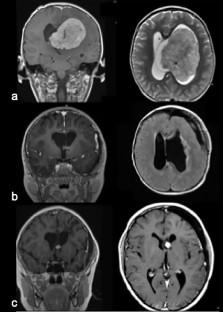Child's Nervous System ( IF 1.4 ) Pub Date : 2023-09-02 , DOI: 10.1007/s00381-023-06105-w Kelsey D Cobourn 1 , Kelsi M Chesney 1 , Kyle Mueller 1 , Islam Fayed 1 , Deki Tsering 1 , Robert F Keating 1

|
Purpose
Subependymal giant cell astrocytoma (SEGA) is a WHO grade I pediatric glioma arising in 5–15% of patients with tuberous sclerosis (TSC). Rare cases of isolated SEGA without TSC have been described. The etiology, genetic mechanisms, natural history, and response to treatment of these lesions are currently unknown. We describe two such cases of isolated SEGA with follow-up.
Methods
Retrospective review was performed at a single institution to describe the clinical course of pathology-confirmed SEGA in patients with germline testing negative for TSC mutations.
Results
Two cases of isolated SEGA were identified. Genetic analysis of the tumor specimen was available for one, which revealed an 18 base pair deletion in TSC1. Both cases were managed with surgical resection, one with preoperative embolization. In spite of a gross total resection, one patient experienced recurrence after three years. Treatment with an mTOR inhibitor led to a significant interval reduction of the mass on follow-up MRI. The patient tolerated the medication well for 6 years and is now off of treatment for 2 years with a stable lesion.
Conclusion
Cases of SEGA outside of the context of TSC are exceedingly rare, with only 48 cases previously described. The genetic mechanisms and treatment response of these lesions are poorly understood. To date, these lesions appear to respond well to mTOR inhibitors and may behave similarly to SEGAs associated with TSC. However, given that experience is extremely limited, these cases should be followed long term to better understand their natural history and treatment response.
中文翻译:

无临床结节性硬化症的孤立性室管膜下巨细胞星形细胞瘤(SEGA):两例报告和文献综述
目的
室管膜下巨细胞星形细胞瘤 (SEGA) 是一种 WHO 1 级儿童神经胶质瘤,发生于 5-15% 的结节性硬化症 (TSC) 患者。没有 TSC 的孤立 SEGA 的罕见病例已被描述。这些病变的病因、遗传机制、自然史和治疗反应目前尚不清楚。我们描述了两个这样的孤立的 SEGA 案例并进行了跟踪。
方法
在单一机构进行回顾性审查,描述 TSC 突变种系检测阴性患者经病理证实的 SEGA 临床病程。
结果
发现了两例孤立的 SEGA 病例。对其中一个肿瘤样本进行了遗传分析,结果显示 TSC1 中有 18 个碱基对缺失。两例均通过手术切除进行治疗,其中一例采用术前栓塞治疗。尽管进行了总体切除,一名患者在三年后仍出现复发。mTOR 抑制剂治疗导致随访 MRI 中肿块显着减少。患者对药物的耐受性良好,长达 6 年,现已停止治疗 2 年,病变稳定。
结论
TSC 之外的 SEGA 案例极为罕见,之前仅描述过 48 例。这些病变的遗传机制和治疗反应尚不清楚。迄今为止,这些病变似乎对 mTOR 抑制剂反应良好,并且可能与 TSC 相关的 SEGA 表现相似。然而,鉴于经验极其有限,应长期跟踪这些病例,以更好地了解其自然史和治疗反应。



























 京公网安备 11010802027423号
京公网安备 11010802027423号